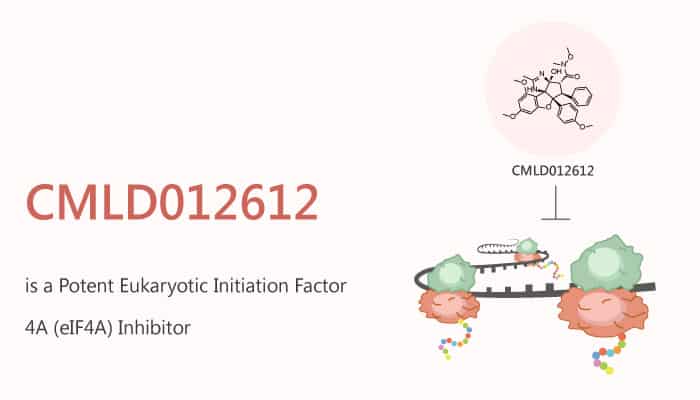Small molecules show targeting the translation machinery that can be used for the research of cancer, viral infection, and neurodegeneration. In particular, a class of translation inhibitors that possess potent cytotoxic activity against tumor cells is in the development.
In this article, we will introduce a potent eukaryotic initiation factor 4A (eIF4A) inhibitor, CMLD012612.

The eIF4F complex recognizes mRNA cap structures via its eIF4E subunit remodels adjacent mRNA structure via eIF4A . In addition, it recruits 43S pre-initiation complexes through its eIF4G subunit.
The eIF4F complex possesses only 5% of eIF4A, this means multiple eIF4A molecules may have non-eIF4F related activities in translation. the previous lead compounds CR-1-31-B and CMLD012073 have an inhibitory effect on cellular translation and cytotoxicity toward NIH/3T3 cells. They have a blunted cytotoxicity in eIF4A1em1JP cells, which is a CRISPR-engineered NIH/3T3 line harboring rocaglate-resistant eIF4A1(F163L) alleles. this means the mechanism of action of CMLD012612 is eIF4A1 dependent.
CMLD012612 is an amidino-rocaglate containing a hydroxamate group. CMLD012612 inhibits cell translation and is cytotoxic to NIH/3T3 cells with an IC50 value of 2 nM. Additionally, CMLD012612 inhibits eukaryotic translation initiation by modifying the behavior of the RNA helicase (eIF4A). It also possesses potent anti-neoplastic activity.
The IC50 of CMLD012612 toward NIH/3T3 cells is 2 nM. The primary mechanism of action of CMLD012612 is dependent on eIF4A1 since eIF4A1em1jp cells are at least 10-fold more resistant than parental NIH/3T3 cells. The sensitivity of eIF4A1em1jp cells to CMLD012612 needs higher concentrations may due to the presence of wild-type eIF4A2 in the cells.
In Female C57BL/6 mice, CMLD012612 treatment effectively suppresses liver polysomes 3 hours after injection. This indicates that inhibitory activity toward protein synthesis.
When administered to mice bearing myr-Akt/Em-Myc lymphomas, CMLD012612 (0.2 mg/kg) treatment effectively synergizes with Doxorubicin, leading to complete tumor loss.
In conclusion, CMLD012612 is a useful eIF4A inhibitor and can be used for cancer research.
Reference:
Chu J, et al. Cell Chem Biol. 2019 Nov 21;26(11):1586-1593.